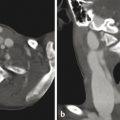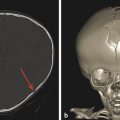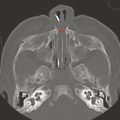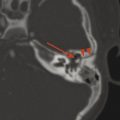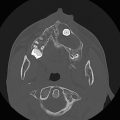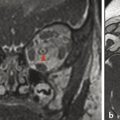17 Neck Soft Tissue
17.1 Introduction
The soft tissues of the neck can be an intimidating area to evaluate radiologically. However, children have numerous congenital and acquired abnormalities within the neck that are best characterized on cross-sectional imaging. Familiarity with the anatomy, disease processes, and clinical management of these conditions will facilitate a systematic approach to the imaging evaluation of the pediatric neck and soft tissues.
17.2 Anatomy
Much of the concern about interpretating studies of the soft tissues of the neck comes from uncertainty about the anatomy of the neck. A review of the normal anatomy of the neck as shown in different imaging modalities is a good start to alleviating this uncertainty. Many methods exist for parcellating the anatomy of the neck, including techniques summarized by description of the fascial planes of the neck, by surgical approaches, and by the relationship of anatomic structures of the neck to other structures. Head and neck anatomy can be (and is) the subject of entire textbooks; however, this chapter provides a brief summary of structures of the head and neck that are relevant to pediatric imaging (Fig. 17.1).

Some textbooks separate the spaces of the neck into triangles based on anatomic boundaries, in many cases the musculature of the neck. In this system, the anterior triangle is defined by the midline of the neck anteriorly, the sternocleidomastoid muscle (SCM) posteriorly, the clavicle inferiorly, and the lower border of the mandible superiorly. The posterior triangle is defined by the SCM, trapezius muscle, and clavicle. Both the anterior and posterior triangles are further divided into smaller triangles by the deeper neck musculature, notably the omohyoid and digastric muscles, which help to further define anterior subtriangles (submental, submandibular, carotid) and posterior subtriangles (subclavian, occipital). This system is descriptive, but as the triangles on which it is based have variable depths, they are not all that useful for cross-sectional imaging. A different anatomic classification localizes tissues and organs within the fascial planes, which for the most part run circumferentially in the neck, from superficial to deep.
17.3 Fascial Planes
The superficial fascia of the neck encloses the connective tissue, nerves, and blood vessels just beneath the skin. In the head and neck, unlike the rest of the body, the superficial fascia also envelops the muscles of facial expression and the platysma. Deep to the superficial fascia lies the most external layer of the deep cervical fascia, termed the investing fascia. The investing fascia completely surrounds the submandibular glands and sternocleidomastoid and trapezius muscles, and is contiguous with the masseteric–parotid fascia of the face. Deep to the investing fascia lies the carotid sheath, which encompasses the carotid artery, jugular vein, and vagus nerve. Deep and medial to the carotid fascia lies the visceral or pretracheal fascia, which encompasses the trachea, esophagus, and thyroid gland. Posteriorly, the vertebral fascia surrounds the spinal column and associated muscles. A space between the prevertebral and visceral fascia is important in the spread of infection from the oral cavity to the mediastinum (discussed in Chapter 23).
Depending on the nature of a disease that affects the neck, it may make sense to refer to fascial planes, anatomic triangles, or specific structures, e.g., the carotid bifurcation, in imaging and describing the disease The radiologist can use the anatomic descriptors named above as a tool set when documenting the locations of radiologic findings in the soft tissues of the neck.
17.4 Congenital Lesions
The largest class of congenital lesions of which to be aware in the pediatric neck are congenital cysts of the branchial apparatus. These are more commonly encountered on standardized tests than in clinical practice. There are six branchial apparati (s. Tab.). It is worth noting that some anatomic purists use the term “pharyngeal” instead of “branchial.” The terms are essentially interchangeable, and “branchial” is encountered more often both in clinical practice and in the medical literature, for which reason it is used for the purposes of this chapter.
Branchial component | Muscle | Nerve | Vessel | Bone/soft tissue |
First (mandibular arch) | Muscles of mastication, anterior belly of the digastric, mylohyoid, tensor tympani, and tensor veli palatini muscles | Trigeminal nerve (CN V) | Maxillary artery | Maxilla, mandible, zygomatic bone, incus, malleus |
Second (hyoid arch) | Muscles of facial expression | Facial nerve (CN VII) | Stapedial artery, hyoid artery | Stapes, styloid process, hyoid bone (part) |
Third | Stylopharyngeus muscle | Glossopharyngeal nerve (IX) | Common carotid, internal carotid artery | Hyoid bone (part), thymus, inferior parathyroids |
Fourth | Cricothyroid muscle, muscles of soft palate (except tensor veli palatini) | Vagus nerve (CN X) | Subclavian artery (right), aortic arch (left) | Superior parathyroid glands, thyroid cartilage |
Sixth | Intrinsic muscles of larynx (except cricothyroid muscle) | Vagus nerve (CN X), recurrent laryngeal nerve | Pulmonary artery, ductus arteriosus (left) | Cricoid cartilage, arytenoid cartilage |
Of the six branchial arches, the first four can give rise to congenital cysts, which embryologically are related to entrapped cells that form a cyst. Associated with the cyst, there will usually be a sinus tract, which for cysts of the first and second branchial apparatus connects to the skin surface, and for the third and fourth branchial apparatus connects to the upper aerodigestive mucosa. In the presence of a congenital cyst, the sinus tract may be relatively obliterated and be evident only as a small cutaneous pit, or it may be in free communication with the cyst. Branchial cysts can present because of mass effect or palpable/visible swelling, or they may present with an infection. In the acute setting, it can be difficult to determine whether an abscess represents a suppurative lymph node, a soft tissue abscess, or an infected branchial cyst. An infected cyst can look like an abscess; however, it will typically have a more spherical shape and circumscribed margins than an abscess arising from a necrotic lymph node. Follow-up may be required to determine whether the lesion resolves after treatment of the infection.
Cysts of the first branchial apparatus are embryologically associated with the external auditory canal (EAC). The sinus tract may extend to the EAC itself (a type A cyst of the first branchial apparatus) or to a preauricular pit (a type B cyst of the first branchial apparatus). The cysts can be intraparotid.
A cyst of the second branchial apparatus will have a cutaneous pit in the upper neck below the angle of the mandible, but its location is highly variable. The subclassification of second branchial cysts is based on their relationship to other structures, with the most common classification system having four subtypes. Although the subtypes of second branchial cyst are commonly described as types I through IV, I refer to them as types A through D. This avoids the confusion of describing a type I second branchial cyst as opposed to a type II first branchial cyst, by instead describing these two lesions as a type 2A and a type 1B cyst, respectively. Because cysts of the second branchial apparatus constitute nearly 95% of all branchial cysts, familiarity with the classification (and clarity in the description) of these entities is warranted.
The four subtypes of cyst of the second branchial apparatus (also referred to as the second branchial cleft) are based on the depth of the cyst from the skin, from the most lateral to the most medial, with a type A cyst being the most superficial and a type D cyst being the deepest (Fig. 17.2). A type A cyst is deep to the platysma muscle and anterior to the sternocleidomastoid muscle. A type B cyst, the most common, abuts both the internal carotid artery and internal jugular vein. A type C is is located between the internal and external carotid arteries, and a type D cyst is medial to the internal and external carotid arteries and abuts the pharyngeal wall.
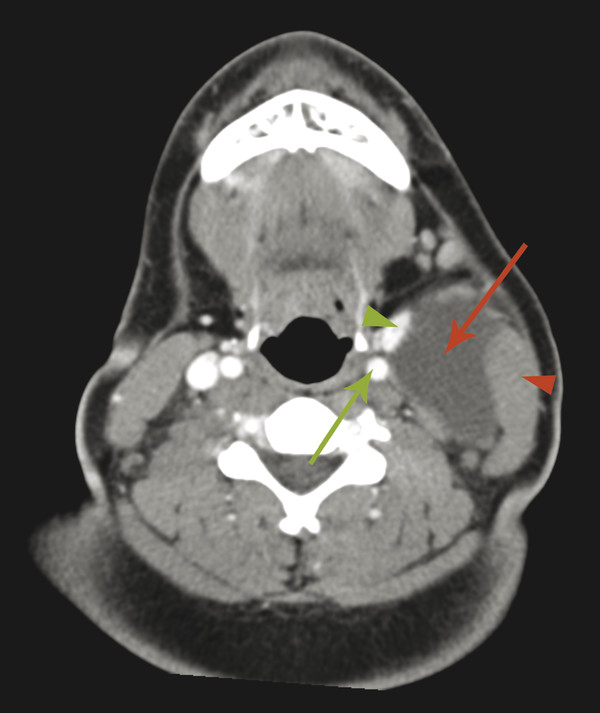
It is critical to be aware of conditions that mimic branchial cysts, in particular a cystic metastatic lymph node. Although metastatic lymph nodes are not common in children, they are more common in young adults and older individuals, particularly as a result of papillary thyroid cancer or carcinoma of the head and neck associated with human papillomavirus (HPV) infection. Therefore, diagnosing a cyst as a branchial apparatus cyst should be avoided in persons beyond adolescence, unless the cyst was known to be present in childhood. Additionally, other etiologies should be considered even for patients in their mid to late teenage years.
A cyst of the fourth branchial cleft develops together with the upper lobe of the thyroid gland, and the sinus tract of this cyst extends to the apex of the left piriform sinus. The most common presentation of a cyst of the fourth branchial cleft (albeit a rare entity) is an abscess within the upper pole of the left lobe of the thyroid (Fig. 17.3). When this diagnosis is suspected, evaluation of the apex of the piriform sinus can provide confirmatory information. This can be evaluated otolaryngologically by direct laryngoscopic visualization, or with a carefully performed barium study. Some authors have recently postulated that the intrathyroid cyst actually arises from the third branchial apparatus, as opposed to the fourth.

Awareness of three congenital cystic lesions of nonbranchial origin is important. The first is a duplication cyst. Duplication cysts can be of enteric or respiratory origin, with differentiation of the two being difficult without histologic analysis of the epithelial lining of the cyst. Collectively, duplication cysts can be referred to as upper aerodigestive duplication cysts when their exact origin is unclear. These cysts will be adjacent to the esophagus, pharynx, or tracheobronchial tree. They may be identified as incidental findings or may present when infected, in which case they appear to be abscesses. The cysts may have communication with the lumen of the aerodigestive tract, which can predispose to the accumulation of debris that can serve as a source of infection.
The thyroglossal duct is the embryologic canal extending from the foramen cecum at the posterior base of the tongue caudally, along the anterior aspect of the midportion of the hyoid bone, and inferiorly to the expected location of the thyroid gland. Cystic remnants of the thyroglossal duct may be identified at any point along its course (Fig. 17.4). Above the hyoid bone the cyst will always be at the midline, but below the hyoid bone it may be slightly off midline. When a cyst is suspected, it is important to look for possible ectopic thyroid tissue, as well as to confirm the presence of orthotopic thyroid tissue having a normal appearance. If there is ectopic thyroid tissue within a cyst and no orthotopic thyroid tissue, removal of the cyst (and associated ectopic tissue) will result in permanent hypothyroidism. The presence and distribution of normal thyroid tissue can be determined with a 99mTc-sestamibi scan . When a cyst of the thyroglossal duct is to be surgically removed, the entire tract must be resected, along with the middle third of the hyoid bone, to prevent recurrence; this is known as the Sistrunk procedure.

A congenital thymic cyst can also be identified in the lower neck. This is typically an incidental finding, but it has the potential for superinfection. The congenital thymic cysts that develop in this location are most often unilocular and have thymic tissue along the cyst wall. If a multilocular cystic lesion is identified, without signs of an infectious etiology, a lesion of vascular origin, such as a lymphatic malformation (a.k.a., lymphangioma or cystic hygroma) or venous malformation (previously known as a cavernous hemangioma), should be suspected; refer to Chapter 19 for further description of these entities.
Stay updated, free articles. Join our Telegram channel

Full access? Get Clinical Tree


